Black Carpet Beetle
Do you have a black carpet beetle infestation in your home? Schedule a service with us to get rid of pests.
Black Carpet Beetles: What are Those Tiny Hard-Shelled Bugs?
The black carpet beetle (Attagenus unicolor) is the most frequently encountered and economically impactful carpet beetle in the US. This stored product pests’ common name refers to its all-black coloration. Many people experience an allergic reaction to carpet beetle larval hairs and blood. These beetles live all over the US, but they’re most common east of the Rockies and in northern states.
The black carpet beetle (Attagenus unicolor) is a stored product pest that gets its name from its all-black coloration. These beetles are most common east of the Rocky Mountains and in the northern United States, however, they can be found all over the country.
What Do Black Carpet Beetles Look Like?
Black carpet beetles measure ⅛ to ¼ inches long and are either dark brown or black in color. Their bodies are oval-shaped and resemble a shield.
What Do Their Larvae Look Like?
Black carpet beetle larvae are ¼ inches long, brown or reddish-brown, and “carrot-shaped.” Larvae appear to have distinct body segments that taper off, becoming thinner from head to rear. A distinctive, long tuft of brown hair usually protrudes from the end of the larva’s rear. Larvae may also look as though they’re covered in spines or bristles.
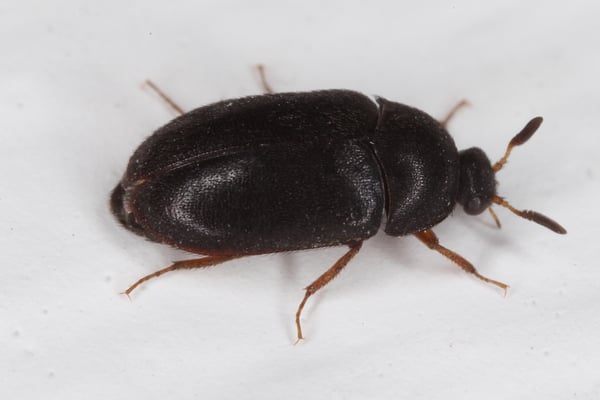
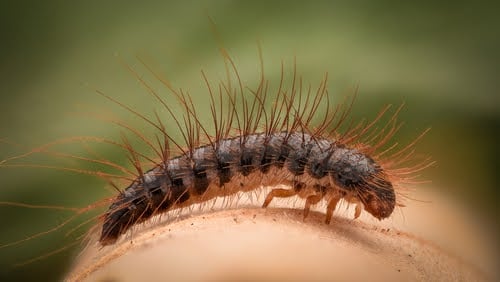
Black Carpet Beetle Life Cycle
Black carpet beetles undergo a complete metamorphosis, hatching from eggs and undergoing larval, pupae, and adult stages. It takes the beetles anywhere between 2 months to 2 years to complete this cycle, depending on environmental temperature.
Black Carpet Beetle Eggs
Female black carpet beetles lay an average of 50 eggs at a time! These eggs hatch into larvae within six to ten days. The beetles spend a majority of their lives as larvae, continuously eating and growing. Black carpet beetle larvae molt 5 to 11 times and grow up to half an inch. After growing sufficiently, larvae pupate for 6 to 24 days. Upon emerging, adult black carpet beetles live 9 months to 3 years, depending on food availability and other environmental factors. They eat pollen and nectar.
Black Carpet Beetle Larvae Diet
Larvae commonly infest bird, rodent, and insect nests. Black carpet beetle larvae frequently consume animal and plant materials including:
- Hair
- Fur
- Feathers
- Hides
- Horns
- Carcasses
- Dead insects
- Cereal
- Stored grain
- Nuts
- Seeds
- Cayenne peppers
- Processed food (such as flour)
Black Carpet Beetle Damage & Dangers
Larvae often chew small, irregular holes into fabrics and chew through hair on fur materials. They’re also capable of burrowing through some packaging materials to infest stored food.
Black carpet beetles will infest and feed on stored food continuously if you let them. The more they eat, the faster they can grow and molt. Upon reaching adulthood, black carpet beetles seek mates and deposit eggs in dark, secluded places near good food sources. They may lay their eggs on top of food sources like carpeting or stored food.
In addition to chewing holes in materials and laying eggs, many people experience an allergic reaction to carpet beetle larvae hairs and blood.
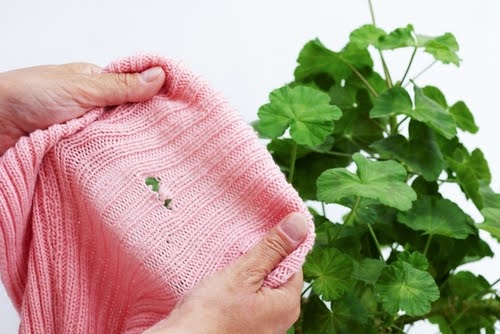
How to Prevent a Black Carpet Beetle Infestation
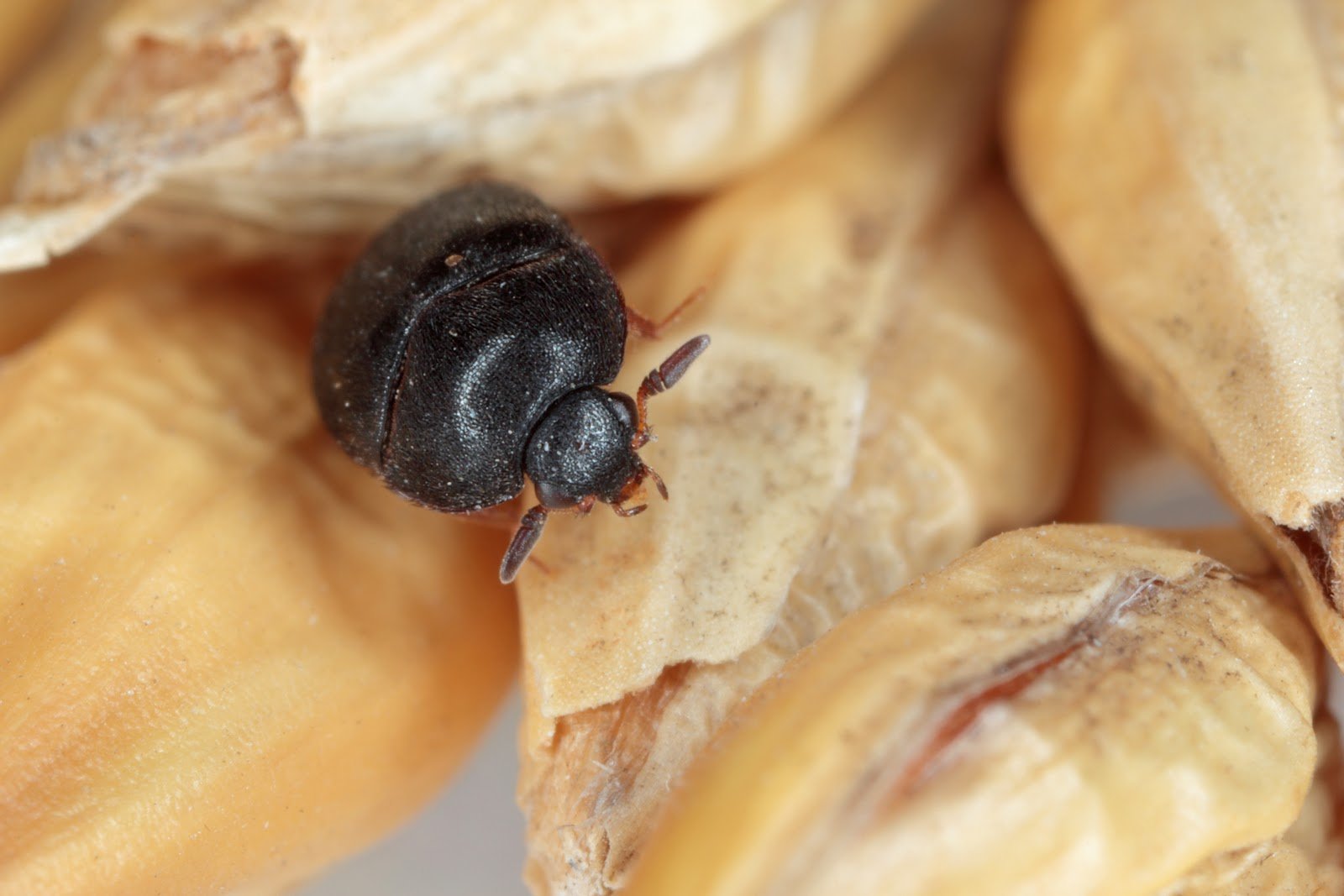
Like most pests, the key to controlling black carpet beetles is to cut them off from their food sources.
- Start by looking for areas around your space that contain the remains of overwintering pests (cluster flies, boxelder bugs, mice, or even birds)
- Clean up these areas as thoroughly as possible. Make sure you’re wearing appropriate safety gear when dealing with dead pests or their remains.
- If you find beetles, larvae, or frass, remove it using a vacuum cleaner. Throw out the vacuum bag when you’re finished.
- Store food (including pet food) in airtight, hard plastic containers.
- Vacuum and clean carpet and fabric regularly.
- Clean up after every meal and don’t leave dirty dishes sitting out.
- Inspect animal products like taxidermy, wood hangings, and feather products for infestation.
Pest Control: Black Carpet Beetle Removal Process
If you’re looking for a fail-safe way to rid your space of black carpet beetles, contact Plunkett’s. Our objective, as always, is to wipe out your current infestation and prevent future infestations at the same time.
One of our technicians will quickly remove all visible, accessible black carpet beetle breeding sites. We’ll wipe out both the larvae currently infesting your home and also any eggs that have yet to hatch. Technicians also make insecticide, spot, crack and crevice, and structural void treatments to keep the beetles from sneaking back in.
If you think you have a black carpet beetle problem, reach out right away. We’re ready to wipe out stored product pests and help you feel at peace in your home again.
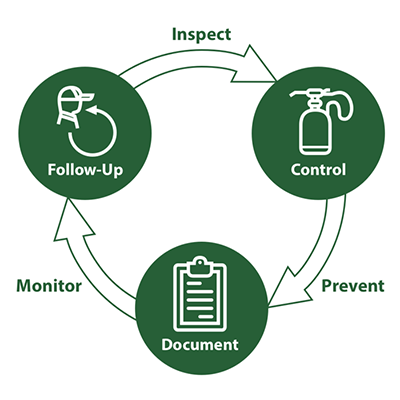
Black Carpet Beetle Control With Plunkett's
At Plunkett’s, our goal is to help you quickly, conveniently, and in the most cost-effective way. We make every effort to be with you asap, usually within a day or two.
Frequently Asked Questions:
I Have Tiny Black Bugs in My House. What are They?
If you’re noticing tiny black bugs in your house, they could be black carpet beetles. These small beetles are known for infesting various household items, particularly fabrics and food. Black carpet beetles are oval-shaped and are black or dark brown in color. Use our pest ID form for more help on finding your household pest.
Where Do Black Beetles Come From?
Black Carpet Beetles can enter homes through open windows, doors, or cracks. They are often brought in accidentally on infested items such as second-hand furniture, clothing, or food products.
Why Do I Have Carpet Beetles in My Bedroom?
Carpet beetles in the bedroom can be due to the presence of suitable food sources like woolen fabrics, carpets, or pet hair. They can also thrive in undisturbed areas, making bedrooms a common spot for infestation.
Why Are There Beetles in My House?
Beetles enter homes in search of food and shelter. If your house provides food sources like fabrics, carpets, or stored food products, and entry points like gaps or open windows, beetles may find it an ideal habitat. Contact Plunkett’s to get rid of unwanted visitors.






